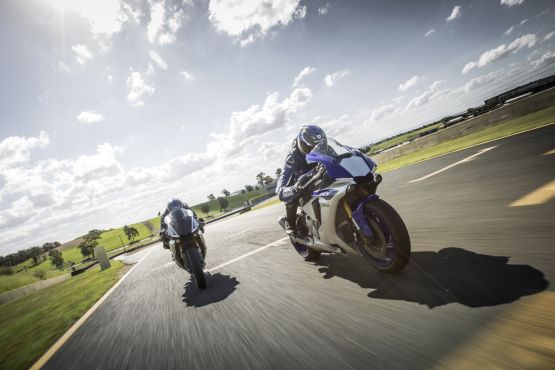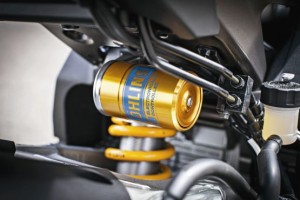 YZF-R1M
YZF-R1M
After three sessions on the standard R1 we got two on its upmarket, limited-edition derivative, the R1M, which combines the same powerplant with a chassis featuring carbon-fibre bodywork and Öhlins semi-active suspension, also linked to the bike’s IMU nerve base. The Swedish firm’s Electronic Racing Suspension is very similar to the system used by the 1299 Panigale, and is every bit as impressive, as well as easier to fine-tune via the Yamaha’s simple but effective push-button display.
 The benefit of a semi-active system is that it allows the suspension to be firm when it’s needed (typically the front under braking, the rear under acceleration) and compliant when it’s not. This was well illustrated in the long, super-fast and pretty bumpy first turn, where you brake from high speed. The R1 was firm on the brakes yet floated over the bumps noticeably better than the standard bike.
The benefit of a semi-active system is that it allows the suspension to be firm when it’s needed (typically the front under braking, the rear under acceleration) and compliant when it’s not. This was well illustrated in the long, super-fast and pretty bumpy first turn, where you brake from high speed. The R1 was firm on the brakes yet floated over the bumps noticeably better than the standard bike.
Öhlins say the system, which provides three automatic pre-sets as well as three for conventional electronic adjustment, makes roughly 40 significant suspension adjustments during a typical lap of a circuit such as the Eastern Creek. And it’s easy to fine-tune, too. When I wanted a bit of extra compression damping, it took only a few seconds’ pressing of buttons to dial in a bit more.
The R1M also comes with a polished aluminium tank and swing-arm, a slightly fatter, 200-section rear tyre (of the same RS10, although we were treated to super-sticky Bridgestone slicks on the launch), and a GPS-enabled data-logger. But before you get your hopes up, it is being produced in a strictly limited number and is already sold out in many markets despite being over 20 per cent more expensive than the standard R1.
Hideki Fujiwara, R1 Project Leader:
“This model is mass-produced but the concept is very close to the M1. We wanted to be number one at a circuit and the philosophy is the same. But the method of manufacture is completely different.
“For example, the main frame of the M1 uses a welded aluminium panel but we use a casting. Sometimes the M1 changes, and every time they adjust it and adjust it. We have to produce many, many bikes so we have to choose an easier method for mass production, but the casting is the thinnest one we could use.
“The electronics is very close to the M1’s — over 90 per cent. The IMU [Inertial Measurement Unit] technology comes direct from the M1; the traction control, slide control; the systems the R1 has. The difference is that the M1 is a very special bike for one rider, Rossi or Lorenzo, but the R1 is for many customers, so we have to adjust it more, and the tyres are completely different.
“I think the speed of the sensor is the same, because it’s made by Yamaha, not bought from another company. The racing bike also measures suspension stroke. This R1 doesn’t have that, but maybe in the future…
“The theme of ‘no excuses’ for this bike was my idea. All team-members had to have that feeling in their hearts. The theme for the original R1 was ‘no compromise’, and before developing this motorcycle I thought that was not enough — we needed something even stronger.
“Do we expect the R1 to be the fastest? Of course. We have tested all the rivals, although we don’t have the latest models. Of the previous models, our main rival is BMW. We tested at Fukuroi and Sugo in Japan, at Thunderhill in California, in Europe and also here in Sydney. It was difficult to keep this secret, especially here where there were some spy shots.
“I worried that if we concentrated on performance for the circuit, the customers might not have fun on the road. But before developing the bike I and some other Yamaha chaps rode the M1, at the Fukuroi test course, and we all had the same feeling: it was easy to ride. Very easy. It was very controllable; throttle delivery was very smooth; braking and handling precise; very light weight. I knew then that even if we concentrated on the circuit, the R1 would not be difficult to ride on the public road, so I had confidence.”



Leave a Reply